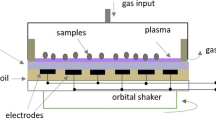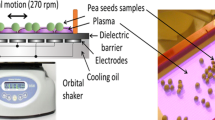Abstract
This study investigated the effect of cold atmospheric pressure air plasma pre-treatment on pea (Pisum sativum L.) seeds. The aim of our study was to verify the plasma impact on DNA damage and the induction of positive adaptive response in pea seedlings. The pea seeds were treated by plasma at the exposure times ranging from 60 to 300 s. Plasma was generated using the coplanar type of dielectric surface barrier discharge. The main plasma properties were estimated by electrical and by optical emission spectroscopy measurements. The DNA damage was evaluated by the alkaline comet assay. The adaptive response on seedlings was tested using the toxic concentration of zeocin. The positive effect of plasma pre-treatment and the reduction of DNA damage of pea seedlings in comparison to control samples without plasma was observed at all exposure times used. The strongest repairing effect was observed at the plasma treatment time in the range from 120 to 240 s. These results verify the safety of plasma application in agriculture at germination and growth enhancement and the existence of a plasma induced adaptive response.








Similar content being viewed by others
References
Randeniya LK, De Groot GJJB (2015) Non-thermal plasma treatment of agricultural seeds for stimulation of germination, removal of surface contamination and other benefits: a review. Plasma Process Polym 12:608–623. https://doi.org/10.1002/ppap.201500042
Hojnik N, Cvelbar U, Tavčar-Kalcher G et al (2017) Mycotoxin decontamination of food: cold atmospheric pressure plasma versus “classic” decontamination. Toxins (Basel). https://doi.org/10.3390/toxins9050151
Lichtenthaler HK (1998) The stress concept in plants: an introduction. Ann N Y Acad Sci 851:187–198. https://doi.org/10.1111/j.1749-6632.1998.tb08993.x
Crawford DR, Davies KJ (1994) Adaptive response and oxidative stress. Environ Health Perspect 102(Suppl):25–28. https://doi.org/10.1289/ehp.94102s1025
Azzam EI, Raaphorst GP, Mitchel REJ (1994) Radiation-induced adaptive response for protection against micronucleus formation and neoplastic transformation in C3H 10T1/2 mouse embryo cells. Radiat Res 138:S28–S31. https://doi.org/10.2307/3578755
Asad LMBO, Asad NR, Silva AB et al (1997) Hydrogen peroxide induces protection against N-methyl-N’-nitro-N-nitrosoguanidine (MNNG) effects in Escherichia coli. Mutat Res DNA Repair 383:137–142. https://doi.org/10.1016/S0921-8777(96)00053-5
Asad NR, Asad LMBO, Silva AB et al (1998) Hydrogen peroxide induces protection against lethal effects of cumene hydroperoxide in Escherichia coli cells: an Ahp dependent and OxyR independent system? Mutat Res DNA Repair 407:253–259. https://doi.org/10.1016/S0921-8777(98)00010-X
Loizeau K, De Brouwer V, Gambonnet B et al (2008) A genome-wide and metabolic analysis determined the adaptive response of Arabidopsis cells to folate depletion induced by methotrexate. Plant Physiol 148:2083–2095. https://doi.org/10.1104/pp.108.130336
Huang X, Ho SH, Zhu S et al (2017) Adaptive response of arbuscular mycorrhizal symbiosis to accumulation of elements and translocation in Phragmites australis affected by cadmium stress. J Environ Manag 197:448–455. https://doi.org/10.1016/j.jenvman.2017.04.014
Bucca G, Pothi R, Hesketh A et al (2017) Translational control plays an important role in the adaptive heat-shock response of Streptomyces coelicolor. Nucleic Acids Res 46:223925. https://doi.org/10.1101/223925
Sakamoto-Hojo ET, Mello SS, Pereira E et al (2003) Gene expression profiles in human cells submitted to genotoxic stress. Mutat Res Rev Mutat Res 544:403–413. https://doi.org/10.1016/j.mrrev.2003.07.004
Chen T, Li W, Hu X et al (2014) A cotton MYB transcription factor, GbMYB5, is positively involved in plant adaptive response to drought stress. Plant Cell Physiol 56:917–929. https://doi.org/10.1093/pcp/pcv019
Xu X, Liu C, Zhao X et al (2014) Involvement of an antioxidant defense system in the adaptive response to cadmium in maize seedlings (Zea mays L.). Bull Environ Contam Toxicol 93:618–624. https://doi.org/10.1007/s00128-014-1361-z
Santa-Gonzalez GA, Gomez-Molina A, Arcos-Burgos M et al (2016) Distinctive adaptive response to repeated exposure to hydrogen peroxide associated with upregulation of DNA repair genes and cell cycle arrest. Redox Biol 9:124–133. https://doi.org/10.1016/j.redox.2016.07.004
Sureda A, Capó X, Busquets-Cortés C, Tejada S (2018) Acute exposure to sunscreen containing titanium induces an adaptive response and oxidative stress in Mytilus galloprovincialis. Ecotoxicol Environ Saf 149:58–63. https://doi.org/10.1016/j.ecoenv.2017.11.014
Stolárik T, Henselová M, Martinka M et al (2015) Effect of low-temperature plasma on the structure of seeds, growth and metabolism of endogenous phytohormones in Pea (Pisum sativum L.). Plasma Chem Plasma Process 35:659–676. https://doi.org/10.1007/s11090-015-9627-8
Zahoranová A, Henselová M, Hudecová D et al (2016) Effect of cold atmospheric pressure plasma on the wheat seedlings vigor and on the inactivation of microorganisms on the seeds surface. Plasma Chem Plasma Process 36:397–414. https://doi.org/10.1007/s11090-015-9684-z
Gateva S, Jovtchev G, Stankov A (2015) Salvia extract can decrease DNA damage induced by Zeocin. Int J Pharma Med Biol Sci 4:1–10
Chankova SG, Dimova E, Dimitrova M, Bryant PE (2007) Induction of DNA double-strand breaks by zeocin in Chlamydomonas reinhardtii and the role of increased DNA double-strand breaks rejoining in the formation of an adaptive response. Radiat Environ Biophys 46:409–416. https://doi.org/10.1007/s00411-007-0123-2
Dimova E, Dimitrova M, Miteva D et al (2009) Does single-dose cell resistance to the radio-mimetic zeocin correlate with a zeocin-induced adaptive response in Chlamydomonas reinhardtii strains? Radiat Environ Biophys 48:77–84. https://doi.org/10.1007/s00411-008-0199-3
Černák M, Kováčik D, Ráhel J et al (2011) Generation of a high-density highly non-equilibrium air plasma for high-speed large-area flat surface processing. Plasma Phys Control Fusion 53:124031. https://doi.org/10.1088/0741-3335/53/12/124031
Černák M, Černáková L, Hudec I et al (2009) Diffuse coplanar surface barrier discharge and its applications for in-line processing of low-added-value materials. Eur Phys J Appl Phys 47:22806. https://doi.org/10.1051/epjap/2009131
Hartmann A, Agurell E, Beevers C et al (2003) Recommendations for conducting the in vivo alkaline Comet assay. Mutagenesis 18:45–51. https://doi.org/10.1093/mutage/18.1.45
Collins AR (2004) The comet assay for DNA damage and repair: principles, applications, and limitations. Mol Biotechnol 26:249–261. https://doi.org/10.1385/MB:26:3:249
Gichner T, Patková Z, Száková J et al (2008) DNA damage in potato plants induced by cadmium, ethyl methanesulphonate and γ-rays. Environ Exp Bot 62:113–119. https://doi.org/10.1016/j.envexpbot.2007.07.013
Šimor M, Ráhel J, Vojtek P et al (2002) Atmospheric-pressure diffuse coplanar surface discharge for surface treatments. Appl Phys Lett 81:2716–2718. https://doi.org/10.1063/1.1513185
Navrátil Z, Trunec D, Šmíd R, Lazar L (2006) A software for optical emission spectroscopy-problem formulation and application to plasma diagnostics. Czechoslov J Phys 56:944–951. https://doi.org/10.1007/s10582-006-0308-y
Laux CO (2002) Radiation and nonequilibrium collisional-radiative models. In: Fletcher D, Charbonnier M, Sarma GSR, Magin T (eds) von Karman institute lecture series 2002–07, physico-chemical modeling of high enthalpy and plasma flows. Rhode-Saint-Genèse, Belgium
Reuter S, Sousa JS, Stancu GD, Hubertus Van Helden JP (2015) Review on VUV to MIR absorption spectroscopy of atmospheric pressure plasma jets. Plasma Sources Sci Technol 24:054001. https://doi.org/10.1088/0963-0252/24/5/054001
Sivachandiran L, Khacef A (2017) Enhanced seed germination and plant growth by atmospheric pressure cold air plasma: combined effect of seed and water treatment. RSC Adv 7:1822–1832. https://doi.org/10.1039/c6ra24762h
Gordon IE, Rothman LS, Hill C et al (2017) The HITRAN2016 molecular spectroscopic database. J Quant Spectrosc Radiat Transf 203:3–69. https://doi.org/10.1016/j.jqsrt.2017.06.038
Rahel J, Pavlik M, Holubcik L et al (1999) Relaxing phenomena in negative corona discharge: new aspects. Contrib Plasma Phys 39:501–513
Banzet N, Richaud C, Deveaux Y et al (1998) Accumulation of small heat shock proteins, including mitochondrial HSP22, induced by oxidative stress and adaptive response in tomato cells. Plant J 13:519–527. https://doi.org/10.1046/j.1365-313X.1998.00056.x
Cortés F, Domínguez I, Mateos S et al (1990) Evidence for an adaptive response to radiation damage in plant cells conditioned with x-rays or incorporated tritium. Int J Radiat Biol 57:537–541. https://doi.org/10.1080/09553009014552671
Murali Achary VM, Panda BB (2010) Aluminium-induced DNA damage and adaptive response to genotoxic stress in plant cells are mediated through reactive oxygen intermediates. Mutagenesis 25:201–209. https://doi.org/10.1093/mutage/gep063
Olvera-Carrillo Y, Campos F, Reyes JL et al (2010) Functional analysis of the group 4 late embryogenesis abundant proteins reveals their relevance in the adaptive response during water deficit in arabidopsis. Plant Physiol 154:373–390. https://doi.org/10.1104/pp.110.158964
Kopaskova M, Hadjo L, Yankulova B et al (2012) Extract of Lilium candidum L. Can modulate the genotoxicity of the antibiotic zeocin. Molecules 17:80–97. https://doi.org/10.3390/molecules17010080
Acknowledgements
This work was supported by the Slovak Research and Development Agency under the Contract No. APVV-16-0216 and by Project VEGA 1/0410/18.
Author information
Authors and Affiliations
Corresponding author
Rights and permissions
About this article
Cite this article
Kyzek, S., Holubová, Ľ., Medvecká, V. et al. Cold Atmospheric Pressure Plasma Can Induce Adaptive Response in Pea Seeds. Plasma Chem Plasma Process 39, 475–486 (2019). https://doi.org/10.1007/s11090-018-9951-x
Received:
Accepted:
Published:
Issue Date:
DOI: https://doi.org/10.1007/s11090-018-9951-x




